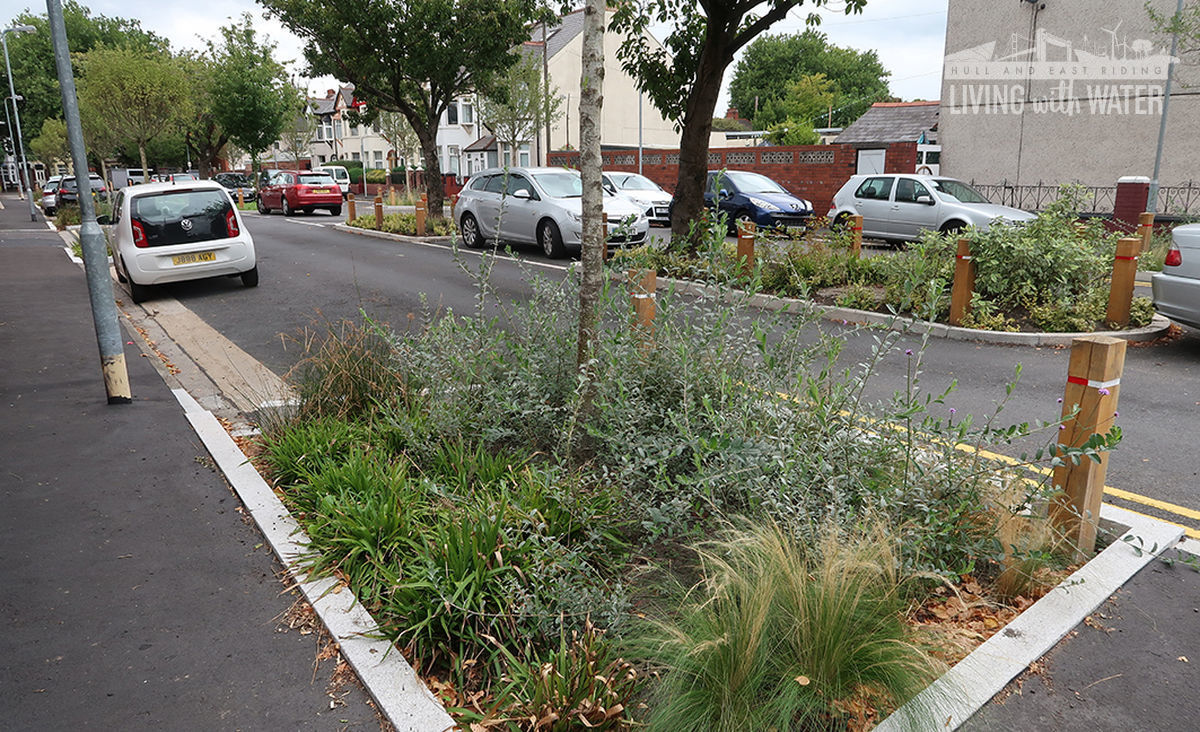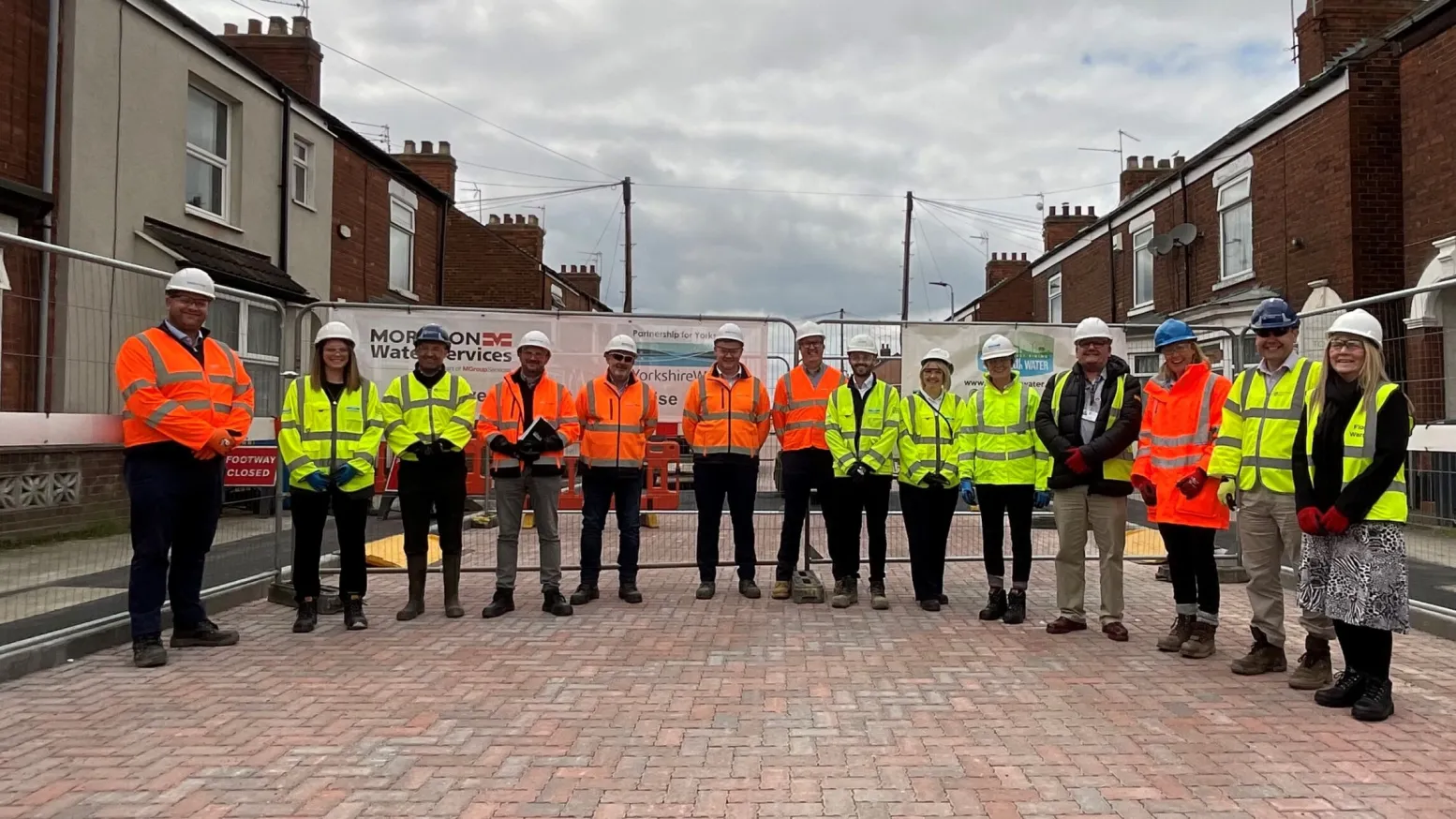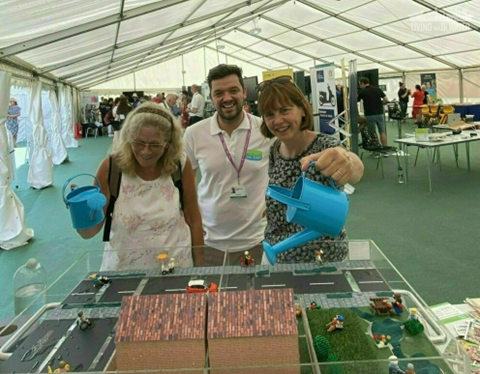20 Sep 2024
How is Action 12 tackling the climate crisis?
The city of Hull sits in a floodplain, with 95-98% of dwellings at high risk of flooding. While the city is protected by engineered, concrete flood barriers, there's a risk that these could be breached, putting many local people at risk from flooding. To build physical resilience to flooding, Hull City Council is designing a series of sustainable drainage systems to be put in place across the city and surrounding villages. The council is also working to build community resilience by co-designing measures and engaging with people whose homes are at risk of flooding.
Sustainable drainage systems collect surface water and channel it away from drains and sewage networks, mimicking natural drainage processes. They might feature pavements that allow water to soak through them, or water butts, or ponds and wetlands. As well as managing flooding, these measures can create more attractive environments, reduce pollution and boost biodiversity.
The council's flood risk team is co-designing multiple aspects of the sustainable drainage systems with residents. This involves completing surveys with council staff, selecting their preferred sustainable drainage systems from multiple options and attending community workshops.
As a member of Living With Water (a partnership that also includes East Riding of Yorkshire Council, Yorkshire Water and the Environment Agency), the council is also engaging more widely with communities on this issue. Living With Water is carrying out a large public engagement campaign, focused in a deprived area of the city with many vulnerable residents. The campaign is uncovering people’s views on what sort of systems should be used, and where they should be placed.
A schools engagement programme is helping young people learn about flood risk, and equipping them to raise the issue with their families. The council is also listening to what students think about potential flood measures and recording the reactions of children to them. Children and young people in Hull attending Guides, Brownies and Scouts can now earn a flood awareness badge, conceived and designed by Living With Water. The council has also launched a social media campaign and is carrying out resident surveys on the issue.
In addition, Hull has brought in novel engagement methods, including the Flood Innovation Centre’s travelling “Floodmobile”, which visited Hull in September 2022. This flood-resilient house on wheels offers a visual display of 50 different home flood defence measures and how they work.
The council wants to involve communities in decision-making so that the additional benefits created by sustainable drainage systems can be delivered through measures that are accepted, and used by, local people. Potential positive impacts include local food growing, traffic calming, and a safer environment for young children playing outside.
What impact has the project had?
Improving existing designs
The local authority has used resident feedback to modify existing designs. By empowering local people to input into its decisions, the council can tackle resident concerns at the beginning of the process, reducing public complaints further down the line, and making it more likely that measures will deliver benefits to local people and remain in place long-term.
Feedback from the public engagement so far includes requests to make local areas more attractive, with a desire for more green features and food growing. Other feedback highlights the importance of access to a personal parking space.
Blue Green Plan
Living With Water’s Blue Green Plan lays out how waterways and nature-based solutions, like blue-green corridors, rain gardens, green roofs, tree canopy layers and sustainable drainage, can improve flood resilience in Hull. The plan aims to reduce the likelihood of flooding for 14,000 properties over the next 60 years, bringing with it more than £2.6 billion in economic benefits to communities across the city. This was calculated by using the Treasury’s Green Book to estimate potential economic damages avoided through reduced flood risk. Susdrain’s BeST tool was also used.
To draw up the plan, wide consultation was required to gather an accurate, on-the-ground picture from residents about the flood risk landscape and what their needs are. Residents were asked about whether they’d experienced the floods of 2007 or 2013, and how this affected them; whether they still felt at risk of flooding now; and whether they’d taken measures of their own to protect themselves. This information was collated and used to model different rainfall events and their possible fallout up to the year 2080.
The plan has already received recognition, winning the Sir John Fowler Award at the Institution of Civil Engineers Yorkshire and Humber Awards 2023.
Rosmead Street
In 2023 the Living With Water partnership began and completed work on its first transformation project on Rosmead Street, based in a dense, diverse, inner-city residential area. The 6-month project has seen the street repaved with 3,775 m2 permeable paving. This paving consists of non-porous blocks with spaces in between to enable water to flow through, reducing surface flood risk. Simultaneously, Hull City Council’s housing department and property refurbishment teams will be renovating the 200+ properties on the street with new frontages, to better convey water from property roofs. Free water butts and planters were offered to households too.
Extensive engagement with Rosmead residents began in November 2021, with regular opportunities to meet face-to-face with the council’s housing team. In the summer of 2022, surveys were sent out to 430 residents by mail, complimented by door-to-door hand delivery. In January 2023 Living With Water held an engagement day at a nearby primary school, delivering an assembly, themed lessons and sessions to co-design sustainable drainage systems on the school grounds, which the council will install in 2023. Pupils were also invited to Rosmead Street to get hands-on laying some of the new permeable street blocks.
While the works are underway, pop-in events are to be held every fortnight at a church on Rosmead Street to hear and respond to any resident concerns arising over the 6 months.
The Rosmead transformation is the first part of a £23 million Living With Water investment in similar surface water schemes across Hull over a 5-year period.
"[Rosmead Street] is the first project of our Blue Green vision which aims to increase flood resilience in the local area by managing surface water better during periods of heavy rain. We’ve engaged with the local community to understand what’s important to them and how we can work together to implement these measures in a way that works for them day-to-day."
Lee Pitcher, General Manager at Living With Water
What made this work?
External partnerships
Yorkshire Water has been a key partner in ramping up engagement, and adapted proven engagement processes from its billing department to be used in this project. The company also helped with communications support and in training up the council’s existing community networks on local water issues.
The authority is also using community groups that have existing networks and are trusted by locals to carry out the engagement. These include Timebank, Groundwork and The Hull We Want. This approach is particularly useful when engaging with diverse communities, or people who may be unsure of engaging with council officers directly.
The local authority took on board key lessons from Hull University and the University of Sheffield. Both institutions have delivered community engagement projects across Hull to raise awareness of water and flood resilience. Key points such as making residents feel empowered and listened to were fed directly into this engagement process.
Notify communities of surveys and listen to community concerns
The council is having conversations with members of the community who don't usually engage with it. To encourage local confidence, over 7,000 letters were sent out to specific estates telling residents that council staff and partners would be coming into the community to discuss flood resilience.
The authority found many residents had concerns about wider issues beyond the survey brief. It's important to listen to all these points when engaging with people. Residents in Hull raised related social issues, such as crime or anti-social behaviour. Listening to these concerns and flagging them with relevant parties is important for building trust with residents, who may then be more willing to contribute to co-creation projects and aid decision-making.
In the case of Rosmead Street, the council originally offered planters to each household, but found that with limited street space residents were concerned about parking pressures. To ensure that there was still a benefit to nature, the council offered swift and bat boxes as an alternative to planters. It's also looked to other nearby spaces to offer improvements. By planting a wildflower mix, biodiversity net gain has been achieved in the local green space used for temporary parking while the Rosmead works were ongoing. St John's Church, where community engagement sessions were held, has been supplied with planters and had its outdoor space transformed into a food-growing community garden. The use of the church as a venue particularly helped the council to hear the views of residents who attended the food bank and warm bank held there, many of whom will now benefit from the new garden.
What resources were needed?
One of the major challenges with a project of this kind is that the funding required is more for revenue than the actual capital. To generate the level of required community involvement, authorities will need long delivery timescales and the involvement of a large number of people. The project is fundamentally about behaviour change, and shifting mindsets from a view that water is "out of sight and out of mind" to seeing it as a positive resource, one that can be used to create multiple benefits.
The project has capital funding through the Water Companies investment programme. The partnership has also bid for a central government grant which hasn't yet been secured, as the process doesn't align well with a project of this nature, which requires extensive community co-creation.
A team of 6 dedicated Yorkshire Water officers works on this project. They're supported by Hull City Council and East Riding of Yorkshire Council Flood Officers.
Lessons from Hull
Liaise funding contracts, involve communities and be realistic
A significant challenge when bringing communities into council decision-making is navigating funding requirements and key performance indicators. On this project, funded by water companies and potentially funded in the future by the government, the results needed to include ensuring retrofitted sustainable drainage systems can store a pre-determined volume of water.
Such requirements make it harder to engage communities. Where they're a barrier to residents’ priorities or suggestions, people may feel their specific needs aren't being catered for or taken into account. When overcoming this, it's important to be honest with community members, manage expectations and not oversell local changes that are offered up in public decision-making processes.
Learn from other departments and mirror their success
Hull City Council’s flood risk team took on lessons from the council waste team’s recycling engagement, which was mainly carried out through schools and used children to drive behaviour change. The flood risk team adopted this approach, putting water and flooding onto the curriculum and offering a lesson and assemblies for students aged 8 to 10.
"The Living With Water partnership created after the 2007 floods is showing the rest of the country what can be done through greater agency co-operation and increasing public awareness. But we still have work to do supercharging community engagement and […] getting government to make the changes necessary to allow us to get on with the job of protecting homes and businesses."
Emma Hardy, Member of Parliament for Kingston Upon Hull West and Hessle
Friends of the Earth's view
It’s good to see that Hull City Council, with its partners, is trying new ways to engage vulnerable communities and co-design solutions. It would be great to see Hull roll this out across the implementation of its Climate Change Strategy.
Hull needs to ensure it has a sense of urgency across all its climate actions and to make sure all departments are acting in line with climate mitigation and adaptation, for example removing trees is counterproductive to a more flood-resilient city.
Hull’s commitment to working closely with communities as it's done in Rosmead Street is to be applauded: it's listening to what residents want. However, if it’s serious about its climate commitments, the council now needs to consider how it can help residents to be less dependent on cars and more open to green infrastructure replacing some parking spaces. A proposal in June 2023 to allow cars back into bus lanes won’t help to make public transport an attractive alternative and is being opposed by Hull Friends of the Earth.
Central government also needs to act. Hull’s experience illustrates how changes to funding would help more councils to roll out flood resilience measures that are co-designed with communities.
Friends of the Earth is showcasing specific examples of good practice in tackling climate change, but that doesn’t mean we endorse everything that a council is doing.
This case study was produced by Ashden and Friends of the Earth. It was originally published in March 2022 and was last updated in August 2023. Any references to national policy in this case study relate to policy under the previous government and reflect the policy context in which the council was operating at the time.







